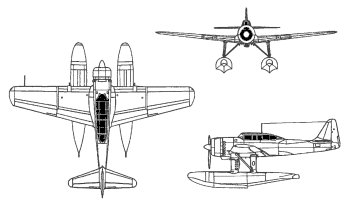



The Aichi E16A Zuiun (Auspicious Cloud) was designed as a considerably improved successor to the E13A. Compared to its predecessor, it offered superior performance and heavier gun armament, unfortunately it did not enter service until late in the war by which time the Japanese had all but lost air superiority. As a result, the Zuiun found it increasingly difficult to perform in its intended reconnaissance without significant opposition from Allied fighters and ended up being converted into a dive bombing platform with the inclusion of hydraulically operated dive breaks as well as kamikaze aircraft during the final stages of the war. The Zuiun remained in production until the end of hostilities although it suffered from the deteriorating situation of Japanese industry which was worsened by the onset of B-29 bombing raids and the lack of skilled labor.
The first prototype of the 'Paul' flew as early as May 1942 but it was never given due priority, the result being that the production E16A1 did not enter service until early 1944. No other variants of this floatplane were built although some were modified as dive bombers while an improved E16A2 with an uprated Kinsei 62 engine never left the prototype stage.
Preceded by:
NoneSucceeded by:
None | |
| Design | E16A1 |
| Name | Zuiun |
| Code Name | Paul |
| Type | Reconnaissance |
| Year | 1944 |
| Crew | 2 |
| Dimensions | |
| Length | 10.83 m |
| Height | 4.780 m |
| Wing Span | 12.80 m |
| Wing Area | n/a |
| Weight | |
| Empty | 2,945 kg |
| Maximum | 4,553 kg |
| Wing Loading | 162.6 kg/m² |
| Performance | |
| Speed | 440 km/h |
| Ceiling | 10,000 m |
| Range | 2,420 km |
| Powerplant | |
| Engine | 1 x Kensei 51/54 Mitsubishi 969 kW |
| Thrust/Weight | 0.40 |
| Armament | |
| Guns | 2 x 20-mm 1 x 13-mm |
| Payload | 500 kg |
| Production | |
| Built | 252 |
| Total | 256 |